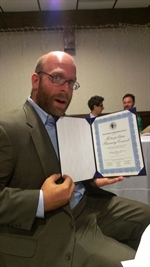
Abby Crisostomo
 By Josh Ellis and MPC Research Assistant Jamie Makatche
By Josh Ellis and MPC Research Assistant Jamie Makatche - October 4, 2013
More than 80 community leaders, elected officials, public administrators and land managers gathered on Thursday, Sept. 26, 2013, at the Metropolitan Water Reclamation District of Greater Chicago (MWRD) Sustainability Summit in Midlothian, Ill. Experts presented on a range of ways to bridge stormwater management, resource recovery and community development.

MPC's work on the Milwaukee Avenue Green Development Corridor has informed a lot of our work.
Metropolitan Planning Council (MPC) was proud to receive one of MWRD’s Sustainable Landscaping Awards for its work with the Milwaukee Avenue Green Development Corridor. This project was born out of a $200,000 Illinois Green Infrastructure Grant from the Ill. Environmental Protection Agency; MPC led this project, and the City of Chicago, Ald. Rey Colón (35th Ward) and the Chicago Community Loan Fund provided support. The funds enabled residents and business owners along Milwaukee Avenue in Chicago’s Logan Square neighborhood to secure financing for green, water-saving projects. Examples of these projects include green roofs, permeable pavers, rain barrels and rain gardens.
In highly urbanized areas where the majority of stormwater falls on private property, we need effective strategies for spurring investment in publicly beneficial green and gray infrastructure on private property. As I explained in my closing presentation at the Summit, with four projects fully completed, several more being built and a half dozen more pending final approval, the Milwaukee Avenue program is providing tangible results, but also providing informative lessons on how to structure comparable programs in the future. One of MPC’s major stormwater projects in 2014 will be collaborative research with the University of Chicago into effective design of these programs, answering key questions—what has worked elsewhere, what has not, and how do we best establish programs tailored to solve specific stormwater problems?
Summary of Sustainability Summit Speakers:
- David St. Pierre, Executive Director of MWRD, shared MWRD’s quest for zero waste, energy neutrality, phosphorus recovery and denitrification.
- Bob Newport and Jon Grosshans of U.S. EPA Region V spoke about the benefits of native landscaping, giving prominent examples such as the Chicago Botanic Garden and the Inverness Park District. This presentation also included information about the uses of green infrastructure in stormwater management.
- Openlands' Stacy Meyers promoted community and schoolyard gardens as a community-based solution to stormwater management. Meyers highlighted the added social and cultural benefits of community gardening.
-

MWRD is looking into biosolids as a way to recover what was previously considered waste.
- Debbie Meyers-Martin, Marketing Specialist of the Ill. State Treasurer’s Office, shared about financing options.
- Governor Pat Quinn’s Sustainability Director, Eric Heineman, highlighted the work that the governor’s office is doing to promote conservation and recycling.
- Amy Walkenbach from the Ill. Environmental Protecion Agency Bureau of Water promoted the State Revolving Funds Program and the Illinois Green Infrastructure Grant Program. The Village of Midlothian and South Suburban College are both recent recipients of IGIG funds.
- Deborah Stone, Cook County’s Chief Sustainability Officer, discussed the importance of working to make better use of our waste. She explained that demolition materials are routinely discarded, despite their reuse potential.
- Director of the Illinois Department of Natural Resources’ Coastal Management Program, Diane Tecic, spoke about many programs and initiatives that this new program offers that can support stormwater management and habitat restoration.